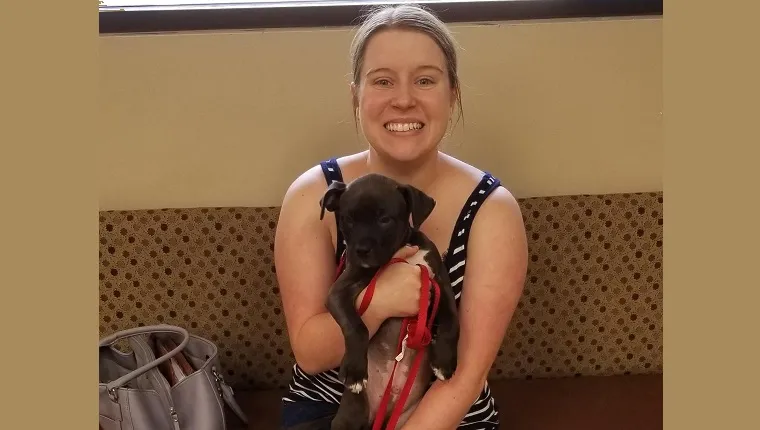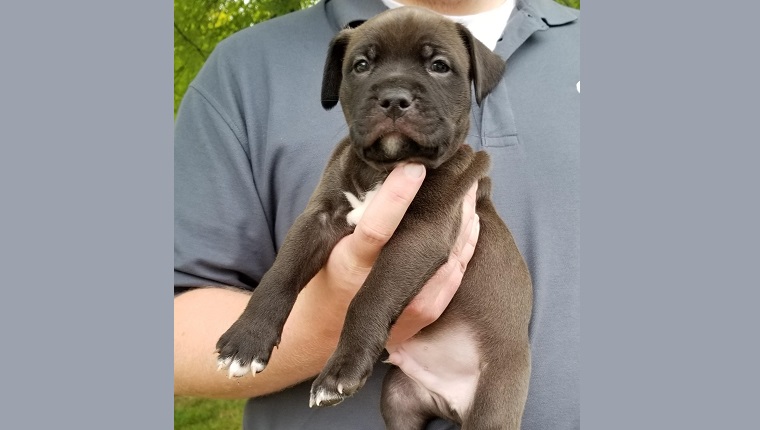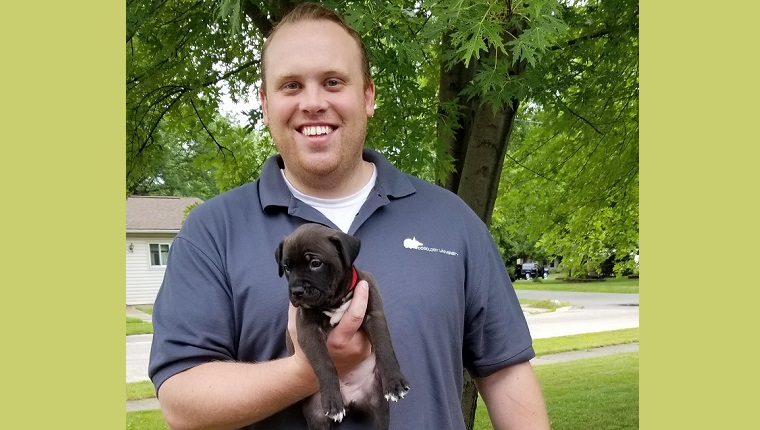Matthew and Ashaleena Lamarand are US military veterans who served as explosive detection dog handlers before founding Dogology University and Pawsome Parents. After realizing 96 percent of surrendered dogs never went through manners or obedience training, they dedicated themselves to training dogs for service dog work.
As someone who suffers from Post-Traumatic Stress Disorder (PTSD) himself, Matthew wanted to help his community by training service dogs for veterans with PTSD. Matthew and Ashaleena have also re-homed their service dogs for children dealing with diabetes, as well as behavioral disorders.
Through research and experience, Matthew has created a revolutionary new training approach, eliminating over-reliance on equipment and treats and focused on building the partnership between human and dog, not just simply making dogs more obedient. His method has helped thousands of dog owners around the world through online courses and seminars along with his Amazon Best Seller Dogology 101–as well as the just-released Dogology 202!
As if that weren’t enough, the Lamarands are working toward a new goal. They want to drop the dog surrender rate by 20 percent in the next five years through their education!
I was able to talk to Matthew about his background, his special dog training methodology, and Valor, the nine week-old Pit Bull rescue puppy who they’re going to give away for free to a Veteran in need!
From Air Force Veteran To Secret Service Dog Handler
MATTHEW LAMARAND: So, a little bit about who I am: I am an Air Force K9 veteran, explosive detection dog handler. I served from 2008 until 2015. We got the news that my daughter was going to be born in December and I was still deployed and actually missed her birth.
It kind of put things in perspective for me and I realized I still want to have a family and I still want to do things, but the military just wasn’t going to be that vehicle for me to accomplish my goals. And so, I got out. But, before I did there were some tornadoes that hit southwest Arkansas and through Little Rock, Arkansas, and President Obama was going to come and provide relief and give a speech and be a morale booster for the area, and I tried out for Secret Service for that mission.
Myself and Kato, my working dog, went through the training, went through the tests and we qualified. You are supposed to get a 97 percent; we were actually able to get a 99 percent overall on the certifications. So, we actually got selected to work for President Obama in Arkansas.
Before [President Obama] left, we got hand selected to follow him to the Northeast where he was about to give his endorsement of Hillary Clinton for the Democratic nomination for President. We traveled for about three months working with Secret Service following President Obama.
BRIAN: A question I’m sure you get a lot is, when you were with President Obama, did you meet the family dogs, Bo and Sunny Obama?
MATTHEW: No. Bo and Sunny stayed in Washington, and Michelle would travel with them. We stayed in the northeast.
BRIAN: Aw, that’s a bummer. You only got to meet the President and not the dogs.
MATTHEW: [laughs]
Rethinking Old Training Methods
MATTHEW: After that, I started working for a private dog training company, that takes in dogs, kind of like what I do now, but every dog that came through there had an e-collar. And they would put pressure, through the e-collar, on the dog, and the dog would then comply, and the pressure is then released.
But I saw that if you didn’t put the e-collar on, the dogs weren’t listening. So, they became “collar-wise,” meaning as soon as they had the collar on, they knew they had to listen, and when it wasn’t on, they knew they didn’t have to. So, I wondered when the e-collar wasn’t on, how do you reinforce behaviors?
It got me thinking more about my own training with the military and how, for a working dog in the military, that is needed. They need to be pristine in the obedience. But why would pet dogs have to be like that?
We can teach using positive reinforcement like clicker training, but I don’t even like clickers because dogs become wise to the clicker, itself. If we don’t have the clicker, they’re not listening. So, I use proofing methods. I do bring in e-collars and choke chains, but then phase them out. It becomes that you don’t need a treat every time you say “sit.” You can expand on what is needed from them.
And I use a variable reward schedule meaning it could be they are rewarded every five minutes or every fifteen minutes or every hour or it could be however many tasks they do in a row. So, if I ask them to do a down, then a sit, then a heel, I’ll reward after three tasks. Other times I’ll reward after the first task. Vary it up so they never know when they will be rewarded, and then they will always be working because they know they eventually will be rewarded.
So, longer durations, variable rewards schedules, and then you incorporate the punishment at the end once they’ve shown you that they know what you’re asking for. And then eventually, you don’t have to punish to get your dog to obey.
That was the biggest thing. When you’re using the pressure of the e-collar, what’s in it for the dog? They don’t want to be shocked. But, when the e-collar is off and you can no longer shock the dog, why would they care? I don’t want to do that. I’d rather have the dog want to enjoy working with me and having fun with it, than being scared and having to do it.
When I say “sit,” the dog has to sit; when I say “come,” the dog has to come. But I also give them the opportunity to be a dog. I reward the positive behaviors, I extinct negative behaviors and, eventually, we have an open communication. It’s all about the tone.
A Life Story Becomes A Training Guide
BRIAN: When did you get the idea about writing a book about this?
MATTHEW: When I got out, everyone asked me about Iraq, about my deployments and President Obama, and so I just wrote a book encapsulating my time. I turned it into lessons on what people can learn from each thing that I talk about and made Dogology 101.
It was never the intention to do it for the [public], it was really just for my friends and family who kept asking about it. When it actually made it to number three on the Amazon bestseller list right behind [Dog Whisperer] Cesar Milan and [celebrity dog trainer] Kyra Sundance, I looked at my wife and was like, “Holy cow! People really care what I have to say. People really want to know. We should help people train their dogs.”
Working Dog Or Pet, The Love Is Strong

BRIAN: When you hear “service dog,” you immediately have an image of a serious, all business, no fun dog. You can forget that these are just dogs. They are serious when they are “on the clock,” but when they aren’t working, they’re lovable and goofy and everything that we love about dogs.
MATTHEW: Oh yeah. You give them a command and they turn that “work” switch on. Once they get their work done, they can turn it off.
Kato was a straight up lover. When we went on Secret Service missions, afterward in the hotels, he would jump up on the bed, curl up in my arms and fall asleep. He was a lover. You HAD to pet him if we weren’t working.
But the second you give a command, when he knew it was time to work, he was completely focused on the task. It’s amazing to see a dog flip the [work and play] switch on and off.
BRIAN: And throughout all of this was your love for dogs? That started before any of this?
MATTHEW: My time with dogs dated back to when I was, probably, two-and-a-half years old. My mom was in the Marines and she was serving in Thailand and I was staying with my grandfather. My grandfather’s dog, Bo, was a Border Collie. Bo passed away and my mom came to pick me up to take me back to South Carolina and my grandpa was like, “You can’t take my grandson. My dog just died. There’s no way this is happening.”
So, my mom left my grandpa’s house and went and got another Border Collie named Nanook. I was actually traded for another dog. So, dogs have always been a part of my life.
And my time deploying, it really did take a toll on my body and it took a toll on my mind. I suffer from depression and I suffer from anxiety.
There was a point it got real dark, and I didn’t think I was going to be able to make it anymore. I owned a Rottweiler named Rocky, and Rocky prevented me from doing anything that I would regret forever.
So, because of that, I dedicated my life, really, because a dog saved my life, to save others. That’s really where it stems from.
BRIAN: I’ve always felt that dogs are great equalizers, no matter what walk of life you come from. I feel like even the most rigid, hard soldier still melts when a dog is around.
MATTHEW: When I was deployed, we did have “Mama Dog.” We found this old stray dog who was probably eight to ten years old, and she had just given birth to puppies. And we would go out, and even the hardest dudes with killer instincts would come out with pancakes and feed her and take care of the puppies. So yeah, I get what you’re saying there.
Dogology Transforms Dog Training
BRIAN: When you wrote your first book, Dogology 101, what did you want to tell people about your approach to dog training?
MATTHEW: That was learning theory because people would ask me questions about how to do this and that, and it’s all really just the theory behind learning and training. Like habituation, hierarchy, intensity, successive approximation, conditioning, and the theory of learning and finding the motivation to help your dog to communicate so you can communicate these different paths for your dog.
It’s about creating a partnership. I don’t really like the whole alpha thing where you have to “alpha role” your dog to make them listen. I believe in really having you and your dog communicate and create a partnership where it’s satisfying for both the dog and the person.
BRIAN: “Bonding with games” is big with Dogology.
MATTHEW: Right. We do talk about using compulsion training, but that’s really in the proofing stage. We don’t need compulsion to teach. There’s no reason to do that.
What we noticed is that we would rather have the dog work for us because they enjoy it, not because they fear us. And that’s really where a lot of the stigmatization is, because I come from the military they think that’s all we use.
But, that’s not true at all. We use compulsion after the dog has taught us and shown us that they know what we’re asking for. Then we will proof it with compulsion to make sure it’s ingrained.
BRIAN: What is it about your approach that sets you apart from other trainers?
MATTHEW: It’s all about taking the techniques from the military and taking the technique from civilian life and blending them into variables and science and allowing the dog to be a dog. Pet dogs aren’t tools. They’re our companions. And, I really believe that my company creates the ideal canine companion.
I believe to say that you “never give a punishment” is incorrect. Because if you withhold a reward, that in itself is a punishment. And it’s a group effort. I don’t just train the dog, I train the owner, also. It makes no sense to do the training and expect the dog to be trained for the rest of their lives. If I do it, the owner needs to be able to do it, too.
The consistency of what’s being requested is super important. And keep in mind about the variables in each situation.
If you call your dog to come in and they don’t, maybe the dog didn’t hear you. Was the dog in such a high drive it didn’t know where it was at? The wind. The weather. Was there a siren that we couldn’t hear but they could? Was there a smell that they smelled that just put them over the top?
You have to account for countless variables because dogs are another living creature that have their own brains.
Training Dogs To Save Lives
BRIAN: I know that your business is still relatively new. But what results have you seen with the therapy dogs you’ve trained?
MATTHEW: We did have a girl around ten years-old who suffers from early onset diabetes, and we taught the dog to alert on the smell of her breath. So, if her blood sugar would go low or high, the dog would alert her. It really did change her life because she didn’t have to have the monitor on at night; that’s when they had the biggest issues. The parents could sleep easy and the child could sleep easy because the dog was always there. It just made life normal for her.
For veterans, and for me, specifically, going out in crowds, we would go to events, and when everyone is moving in one direction to leave a location, it gets packed, and you get claustrophobic. I get anxious. And the dog can actually create a barrier between you and everyone else. And you get a little radius. You get the breathing room. You don’t feel like you’re trapped, and you can actually function. And that gives you the ability to go out in life and continue living instead of being stuck in your house.
For the diabetic alert, we use Labs, Retrievers and Poodles. The Poodles that we get a high recommendation for because they are hypoallergenic, so they are able to go into any home and be a tool and a resource, even if they have allergies to pet dander. And the Lab and Retriever have one of the most advanced noses and are less maintenance.
There was a dog we trained for a child with Asperger’s, and now the parents are confident with the child going back to school, and she is able to interact with her classmates, and she hadn’t had a meltdown for all of last year, which made us pretty proud.
For PTSD, I personally use Shepherds, Malinois, Dutch Shepherds. We’ve used a Mastiff for physical support for a person who needed help getting up stairs.
We just rescued a Pit Bull that we’re using for PTSD alert because they’re going to be denser, so when the veteran has a night terror with the PTSD, the Pit Bull will lay on the chest and force the veteran to wake up, pet the dog, and then the routine is to go outside and get some air and take them for a walk. And it helps the veteran calm down and realize where they’re at and get back to being grounded.
There’s a difference between emotional support dogs and a service dog. Our PTSD alert dogs are service dogs. They’re trained for when you have anxiety; they have a trained response.
When [veterans] come to us, we’re not licensed therapists, but the dog gives them an outlet. The dog is always there to listen. We do recommend that the veteran just talk to them. Let them know their emotions. And the dog can never talk bad about you. They can never go behind your back and reveal your secrets or your hurt. So, that does give the veteran an outlet.
Valor The Pit Bull Puppy Joins The Family

BRIAN: And what about your personal family dogs?
MATTHEW: We have a Dutch Shepherd named Vodnik. Vodnik is like a “velcro dog.” Wherever we go, in each room, he’s right there by our side getting under our feet. He’s very alert and aware when any of us in the family is tense or distraught.
He’s very in tune with our five year-old. They’re best friends. They do everything together. My daughter actually, somehow, trained him to find frogs for her, and I don’t know what she did or how she did it. They both come in with frogs all the time. Buckets and buckets of frogs.
And then we have the rescue Pit Bull we’re training right now for a veteran. That’s actually what I’m hoping–is that this article can help us find a veteran in need. We’re going to give Valor, the rescue Pit Bull, away to a veteran for free.
BRIAN: What can you tell us about Valor?
MATTHEW: He’s a puppy right now. He’s nine weeks old. We’re documenting everything from the day we found out he was going to be given up. And we’re going through the entire process for the next 14 months.
Right now he just has typical puppy behavior. He just reminds me of a little boy cartoon character. I just imagine this cartoon character with a backwards hat and a slingshot in his back pocket. He goes full throttle on everything. Puppy energy. He’s 13 pounds right now.
And with training him, just today we did a leash pressure, and he’s already in tune to that. We did it for 15 minutes today and within five minutes he was understanding “where the leash goes, I’m going to go.” And, he’s coming toward me when I say “come.”
He’s starting to pick up the game, and it’s just a blast. He is so in tune to what my wife and I are doing. He’s a people dog, which makes him perfect for what he’s going to be trained to do.
Resources For Veterans, Education For All
BRIAN: Being that you were in this position at one time, what would you like to say to a veteran who may be having some tough times and is thinking about maybe getting a service dog?
MATTHEW: If you’ve given everything you can to your country and you don’t feel like you’re whole, with Valor we’re hoping to give you part of your life back and be able to acclimate back into civilian life.
Dogology 202 is out, and that’s really a how-to guide, where Dogology 101 was more about learning theory. It has a forward written by Kyra Sundance, and that was a real humbling experience to have her acknowledge that the book is good and that we have worthwhile activities and principles to train your dog.
And if you come to the website, we have free resources. Our whole mission is to give away the education so that we can drop the surrender rate by 20 percent in the next five years.
My biggest thing is that I don’t want it to sound like we’re pushing a product or service. My whole thing is about educating dog owners. They need to know more than just what the standard is of that breed. They need to know how this individual dog gets motivated and works. That’s what I’m hoping to get across.
Dogs And Humans, A Bond That Lasts
BRIAN: What do you think is the reason behind the strong connection between humans and dogs?
MATTHEW: The unconditional love. They don’t expect anything back from you. That is the biggest gift a dog can give. You could make a mistake and they are going to forgive you. They’re always going to be there when you get home. They’re always excited to see you. It is one of the best feelings to receive the love of a dog.
And then when you are actually able to communicate with them and teach them commands and they understand what you’re asking for, it is just one of the most exciting things to get their approval. When they actually show you that they understand it is, to me, one of the best feelings that you can have. Just knowing that your efforts–that you can see it paying off.
BRIAN: Is your five year-old daughter going to follow in her parents’ footsteps?
MATTHEW: Yes! What she wants to do is be an animal doctor, so we’ve got this whole plan where we will do the training, she will do the veterinarian work, and we’ll become a full-on doggie service center.
Follow Up With Matthew And Dogology
If you are a veteran who suffers from symptoms of PTSD and are interested in Valor or anything else relating to service dogs, please contact Dogology University at their website or their Facebook page
For all information about Dogology University head over to https://www.dogologyuniversity.com
And remember to follow Dogology University on Facebook, Instagram, and YouTube!
Are you excited about the work Matthew is doing? What do you think of his training methods? Let us know in the comments below!
DogTime is a participant in the Amazon Services LLC Associates Program, an affiliate advertising program designed to provide a means for sites to earn advertising fees by advertising and linking to Amazon.com.









